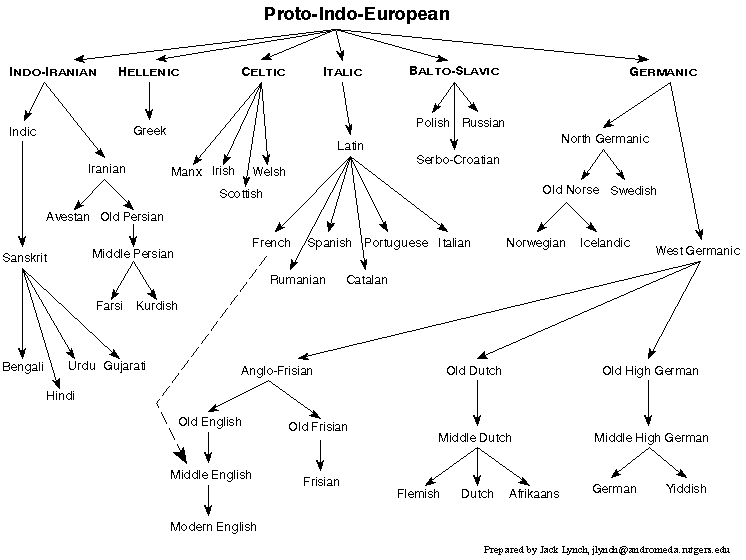What are the hardest languages to learn? It depends on what languages you already speak.
When you peel the onion back to the beginnings of language formation, such as by studying the “Old World Language Families” tree below, you will be able to see where different languages branched off. Now, you may be able to notice why Spanish has similarities with languages like German, Italian, French, etc.
That’s why the hardest languages to learn for native Korean speakers will be different from those that are hardest for native English speakers like us. Today, we’re going to focus solely on the hardest languages to learn for English speakers (hint: they’re located in different branches on the language tree from English!)

Official stats
If you’re looking for official statistics, the Defense Language Institute (where they teach members of the CIA foreign languages!) has organized languages into four categories, the 1st Category being the easiest, and the 4th Category being the hardest languages to learn for English speakers.
-
Category 1: Spanish, Italian, French, Portuguese
-
Category 2: German, Indonesian
-
Category 3: Hebrew, Hindi, Persian Farsi, Russian, Serbian, Tagalog, Thai, Urdu, Turkish, and more…
-
Category 4: Mandarin, Korean, Japanese, Modern Standard Arabic, and more…
7 Hardest Languages in the World for English Speakers to Learn
We’re going to give you the full, extensive list below. Enjoy, and let us know below if you’re going to take on the challenge of learning one of these difficult languages.
1. Mandarin
Number of native speakers: 1.2 billion
Country with the greatest number of speakers: China
Why it’s so hard: It may be the most spoken language in the world, but it comes with its own difficulties for English speakers. Since Mandarin is a tonal language, you can have a completely different meaning of a word just by changing your tone. Add to that thousands of characters, complex systems, and the language’s richness in homophones,[1] and you’ve got one of the hardest languages to learn in the world.

2. Icelandic
Number of native speakers: 330,000
Country with the greatest number of speakers: Iceland
Why it’s hard: While the Icelandic language has not changed much since the island was settled in the ninth and tenth centuries,[2] it continues to add new meaning to old words. It also doesn’t help that there are fewer than 400,000 native speakers who you can learn and practice with.

3. Japanese
Number of native speakers: 122 million
Country with the greatest number of speakers: Japan
Why it’s hard: Japanese has three independent writing systems:[3] hiragana, katakana, and kanji. Before they can start writing, Japanese learners need to learn thousands of different characters in these writing systems. It is, however, easier to learn than Mandarin!

4. Hungarian
Number of native speakers: 13 million
Country with the greatest number of speakers: Hungary
Why it’s hard: Most languages spoken in Europe come from the Indo-European language family shown in the tree above. But not Hungarian. It is instead a Finno-Ugric language[4] in which words are formed in an isolated manner. In other words, it’s nothing like how English speakers normally structure words or sentences. For example, “with my [female] friend” is combined into just “barátnőmmel.” Confused yet? So are we.

5. Korean
Number of native speakers: 66.3 million
Country with the greatest number of speakers: South Korea
Why it’s hard: Korean is a language isolate, which means it isn’t linked to any other language family root. But wait, there’s more. Korean has seven different speech levels which native speakers flip back and forth on, depending on the formality.

6. Arabic
Number of native speakers: 221 million
Country with the greatest number of speakers: Egypt
Why it’s hard: Despite having 221 million native speakers who you can potentially learn from, Arabic is still one of the hardest languages to learn. First, vowels are not included when writing. And, to complicate things further, most Arabic letters are written in four different forms depending on the placement of the word.

7. Finnish
Number of native speakers: 5.4 million
Country with the greatest number of speakers: Finland
Why it’s hard: Ever watched the Lord of The Rings? The Finnish language is what the author J.R.R. Tolkien[5] based the Elvish language on. Finnish, like Hungarian, is a Finno-Ugric language in which grammar complications are taken to the extreme. And, just when you’ve got the hang of translating Finnish to English, you’ll quickly find out that modern Finnish speakers have their own way of expressing emotions that’s different from the traditional translation!

The takeaway
The bottom line is, which are the hardest languages for English speakers to learn depends on a number of different factors, not just one. The number of speakers, the language’s origins, its similarity to English, and other factors contribute to determining how much difficulty you’ll have learning it.
But what’s important is not which is the “hardest language to learn.” As with learning any language, it comes down to how passionate you are about learning, how you’ll deal with psychological fears, and who you to go to for help.
Every language will come with its own challenges, but it’ll also come with its own rewards, experiences, and fulfillment. Remember, whichever language you decide to learn, your time will be well worth the investment.
Reference
| [1] | ^ | Wikipedia: Homophonic puns in Mandarin Chinese |
| [2] | ^ | Iceland: Language |
| [3] | ^ | Wikipedia: Japanese/Japanese writing system |
| [4] | ^ | Wikipedia: Finno-Ugric languages |
| [5] | ^ | Culture Trip: 12 Difficult Books You May Be Assigned Freshman Year |






